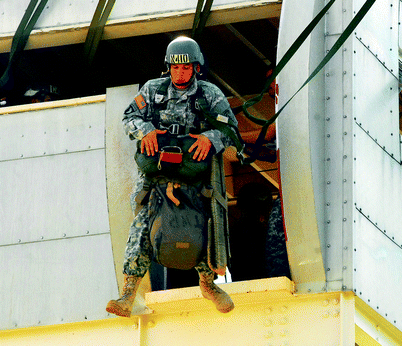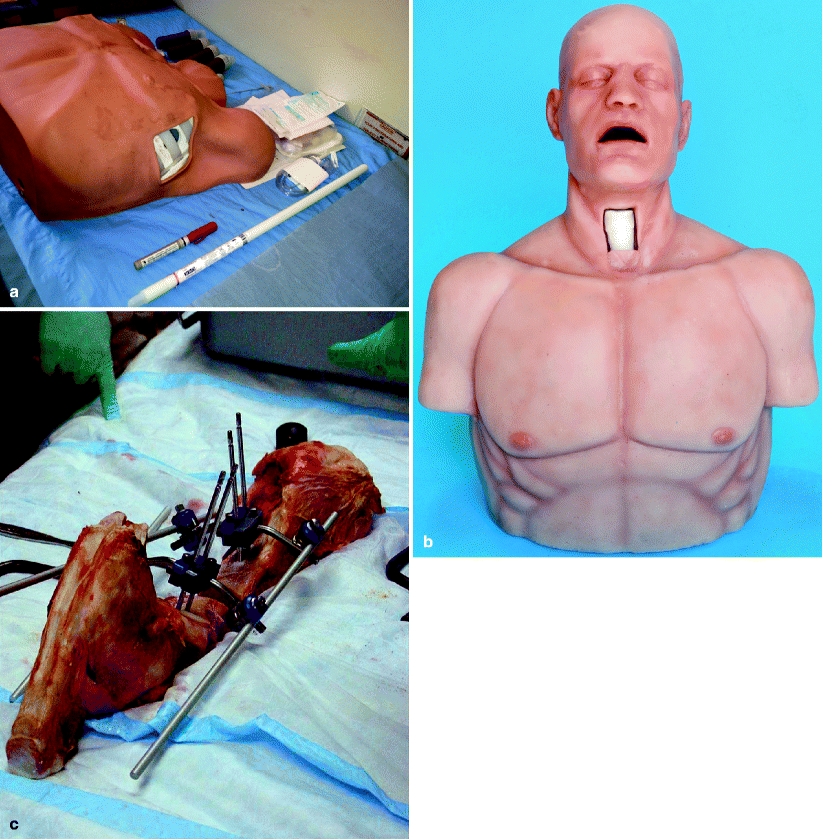Fig. 27.1
Hyperrealistic moulage: (a) chest and abdominal wounds, (b) severe facial trauma, (c) reusable shorts to simulate leg wounds, (d) leg wound shorts (Photos courtesy of Strategic Operations, Inc.)

Fig. 27.2
Hyperrealistic (a) urban battle environment (b) with casualties (Photos courtesy of Strategic Operations, Inc.)
While the military is just scratching the surface in medical simulation, some heroic efforts are currently underway. The military is helping to lead this change both in recognizing gaps in education that can be fulfilled by simulation and in improving the technology and the breadth of application of simulation platforms. For example, depicted in Fig. 27.3a, b are the newest versions of the vehicle rollover trainers used by all personnel deployed to combat zones. These simulators are excellent for improving ability and confidence in egressing from the vehicles especially after rollover accidents. Implementation of these simulators reduced fatalities and actual rollover incidents by over 60% from 2005 to 2007 [2]. Curriculum employed involved 1 h of vehicle safety training and then two to three rollover events on each vehicle simulator. This relatively simple, but expensive (each simulator costs between $10 and $20 million), deployment of simulation has made a tremendous impact on clinical outcomes. In this chapter, we describe the application of simulation for military and battlefield medicine in terms of deployment, wartime practice, and reentry into a civilian medical career.


Fig. 27.3
The ultimate part-task and team trainers: (a) MRAP (Mine-Resistant, Ambush Protected) and (b) HMMWV (High-Mobility Multipurpose Wheeled Vehicle) rollover simulators. Instituting these simulators led to a marked decline in drowning and other rollover-related injuries during combat maneuvers in Iraq
The Uniqueness Brought Out by a Decade of War
The War on Terror has meant that military medical personnel are more likely to be forward deployed and that the modern civilian medicine push towards subspecialization is opposite the needs of military healthcare. Military healthcare personnel are expected to be able to switch into “generalist mode” when deployed. The unique nature of military medicine is centered around the arduous deployment cycle. Massive numbers of active duty and reserve medical personnel are “mobilized” from their routine practice and placed in locations of varying austerity to perform in a different way than they are normally accustomed. When finished with deployment after 3–15 months in this environment, they are then expected to return to their routine practice without missing a beat—a tall order.
Many military healthcare providers expected their practice to cycle in this manner—that is, to practice at home in times of peace and to perform battlefield trauma care in support of our troops in times of war. What could be more heroic and fulfilling? Self-sacrifice during wartime has been the hallmark of our military medical services during all of our country’s conflicts. However, how does one prepare a general surgeon to make the transition from elective hernia repairs at their local hospital to successfully performing lifesaving, complex damage control procedures for horribly injured soldiers on the battlefield? How then does one transition back to routine practice after this experience? This challenge relies on general medical officers that are capable of treating anyone for any reason, as well as general surgeons who are able to do any operation. These omni-capable medical professionals are diminishing [3]. The utilization of curricula augmented by simulation-based educational techniques is key to conquering this problem.
The systems the Department of Defense uses to allow for medical personnel to practice at home base and simultaneously be available for combat support missions are twofold. The system for assigning active duty military personnel to combat units is called the PROFIS (Professional Officer Filler System) system, mainly an Army Medical Department Program. The other system is that of the US Army, Navy, and Air Force Reserves. Regardless of the system, the cycle is similar and is depicted in Fig. 27.4. Deployment intervals vary depending on specialty. For instance, general surgeons, nurse anesthetists, and physician assistants deploy about every 2 years. Deployment length can also vary from 3 to 15 months for most PROFIS personnel, 6–12 months being the most common [4].


Fig. 27.4
The deployment cycle of military medical professionals. The stars represent potential interdiction points where curricula augmented with simulation in a hybrid model can make the transitions efficient
The Cycle
There are few instances outside of the military where vast numbers of healthcare professionals repeatedly rotate in and out of their everyday “practice” of medicine for significant lengths of time. There are civilian programs now available at universities and nonprofit volunteer organizations where healthcare providers visit underserved areas of the world in which their practice of medicine can vary from that in which they practice at home [5–7]. In the case of military surgeons and healthcare providers, the caseload and actual medical/surgical work can be highly variable and differ significantly between home and deployment. Although there are many reports from deployed units describing varied operative experiences and demonstrating robust cases, there are many days when few if any patients are seen or cases performed [8, 9]. To make up for this gap and to fill in this downtime, many units have incorporated host-nation humanitarian care into their routine when not caring for large numbers of combatant casualties [10]. Most credentialing bodies have established a minimum number of cases needed to be performed over a defined time period, a number based on consensus, as there have been no studies other than survey data showing skills degradation in seasoned surgeons or providers [4]. There is a push by some states and accrediting bodies to include simulation testing into overall certification. Interjecting this type of recertification prior to and just after deployments for all military personnel is an onerous task. However, there are some interdiction points where simulation and specific, efficient curricula can and are being used to improve transition, maintain skill levels, and monitor progress (Fig. 27.4).
Pre-deployment Training
Figure 27.4 depicts the cycle of most military healthcare professionals. Starting at home station after residency or schooling, most military providers work very hard to build their “practice” in a variety of settings from small isolated medical clinics at remote bases/posts to highly technical academic teaching centers with a host of subspecialties. In order to deploy, most providers participate in trauma and deployment refresher training. These programs provide training for medical including combat trauma (Fig. 27.5) and troop preventative medicine and nonmedical skills (Fig. 27.6). Currently, the military does well in this area (green-colored star #1 in Fig. 27.4). The available courses are listed in Table 27.1 along with the simulation formats used to support each effort.



Fig. 27.5
Combat surgery at a forward surgical team in Afghanistan

Fig. 27.6
Parachute training: Staff Sgt. Antonio Dipasquate, a trainee with 1st Battalion (Airborne), 507th Parachute Infantry Regiment, jumps with his combat gear. The students first conduct single jumps from the 34-ft towers and then moved on to mass exits with combat gear and the addition of “malfunctions” (Photo Credit: Cheryl Rodewig. Used courtesy of the United States Army)
Table 27.1
Sample courses, simulators used, and locations of training that are available for pre-deployment trauma refresher training
Course | Locations | Learners | Simulators |
|---|---|---|---|
Combat Lifesaver | Most US Army posts | All service members | Part-task trainers and various mannequin-based simulators |
BTC3 (Brigade Tactical Combat Casualty Care) | Fort Sam Houston, TX | All DoD healthcare providers | Part-task trainers for procedures, SimMan 3 G, Trauma Man, live tissue |
Army Trauma Training Center (ATTC) Forward Surgical Team Training | Ryder Trauma Center, Miami, FL | Army forward surgical team members | Part-task trainers, live tissue, cadaver, Sawbones, TraumaMan, live patients (under trauma center oversight) |
STAT Training | Any location | All team members | Moulaged unit members with scripts, SimMan 3 G |
Combat Casualty Care Course (C4) | Camp Bullis, San Antonio, TX | Physicians, nurses, physician assistants new to the Army Medical Department | Part-task trainers |
Combat Extremity Surgery Course | AMEDD Center and School and the Defense Medical Readiness Training Institute, Fort Sam Houston, TX | Surgeons | Sawbones, cadaver, part-task trainers |
Emergency War Surgery Course | AMEDD Center and School and the Defense Medical Readiness Training Institute, Fort Sam Houston, TX | Surgeons | Live tissue, cadaver, part-task trainers |
ATOM (Advanced Trauma Operative Management) | Various level I and II trauma centers | Surgeons | Live tissue model |
ASSET (Advanced Surgical Skills for Exposure in Trauma) | Various level I trauma centers throughout USA | Surgeons | Cadaver |
CSTARS | University of Cincinnati and other locations (colocated with university hospitals’ ICUs and trauma centers) | Critical Care Air Transport Teams (CCATT), other Air Force personnel | SimMan 3 G, C-130 and C-17 aeromedical evacuation platforms |
Of the many training opportunities available in the pre-deployment phase, most focus on combat trauma care. Simulators for pre-deployment combat training range from part-task trainers that allow for the practice of specific, limited range of procedures (Fig. 27.7a–c) to full mannequins that are incorporated into more complex multisystem trauma scenarios for both individual and team training (Fig. 27.8a–c). The Human Worn Partial Task Surgical Simulator (a.k.a. Cut Suit) from Strategic Operations [11] in Fig. 27.9a–g is a wearable simulated torso that an actor or moulaged team member dons to combine total patient injury management with actual procedural skill practice. (Table 27.2 lists the procedures available with the Cut Suit.)


Fig. 27.7




Part-task trainers for (a) chest tube insertion; (b) 6 in 1 torso for tracheostomy placement, needle decompression, and chest tube placement; and (c) external fixator placement (Photo b courtesy of Strategic Operations, Inc.)
Stay updated, free articles. Join our Telegram channel

Full access? Get Clinical Tree








